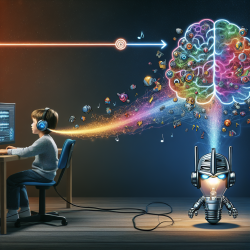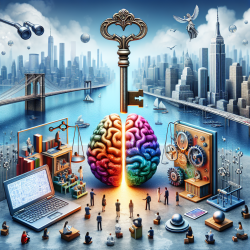Introduction to BENDR: A New Era in EEG Data Analysis
In the ever-evolving field of speech-language pathology, data-driven decisions are crucial for creating impactful outcomes, especially for children. A recent study titled "BENDR: Using Transformers and a Contrastive Self-Supervised Learning Task to Learn From Massive Amounts of EEG Data" offers groundbreaking insights that can significantly enhance how practitioners analyze EEG data. This blog explores the key findings of this study and how you can implement them to improve your practice.
Understanding BENDR and Its Impact
BENDR, which stands for BErt-inspired Neural Data Representations, leverages transformers—a type of deep learning model—to process vast amounts of EEG data efficiently. The study highlights the ability of BENDR to adapt techniques from language modeling to EEG analysis, allowing a single pre-trained model to handle diverse EEG sequences recorded with different hardware and subjects. This adaptability is crucial for practitioners working in varied settings, including online therapy platforms like TinyEYE.
Key Outcomes of the Research
- Universal Feature Learning: BENDR's approach enables the development of universal features that can be fine-tuned for specific EEG classification tasks, such as sleep stage classification, outperforming traditional methods.
- Transfer Learning: The study demonstrates that BENDR can effectively transfer learning across different contexts, making it a versatile tool for practitioners dealing with diverse EEG datasets.
- Enhanced Classification Performance: By using self-supervised learning, BENDR achieves better classification performance compared to previous models, especially in tasks with limited labeled data.
Implementing BENDR in Your Practice
For practitioners looking to integrate BENDR into their practice, the following steps can be considered:
- Stay Informed: Regularly update your knowledge on the latest advancements in EEG data analysis and machine learning techniques.
- Collaborate with Experts: Engage with data scientists or AI specialists to understand the technical aspects of implementing BENDR in your therapeutic interventions.
- Invest in Training: Consider workshops or courses that focus on the application of machine learning in EEG analysis to enhance your skill set.
- Evaluate and Adapt: Continuously assess the outcomes of using BENDR in your practice and make necessary adjustments to optimize therapeutic results for children.
Encouraging Further Research
The potential of BENDR in transforming EEG data analysis is immense, yet further research is encouraged to explore its full capabilities. Practitioners are urged to participate in studies or collaborate on research projects to contribute to the growing body of knowledge in this field.
To read the original research paper, please follow this link: BENDR: Using Transformers and a Contrastive Self-Supervised Learning Task to Learn From Massive Amounts of EEG Data.










